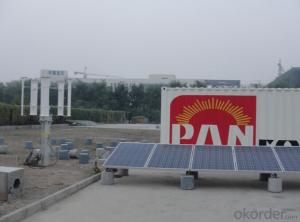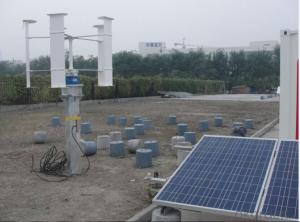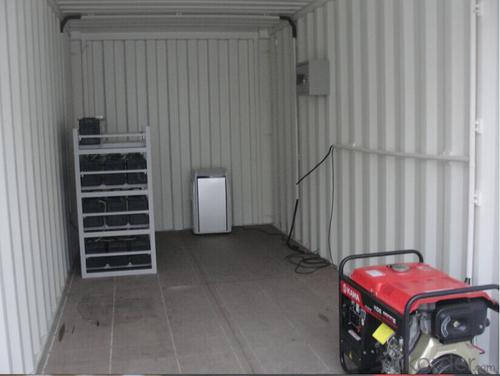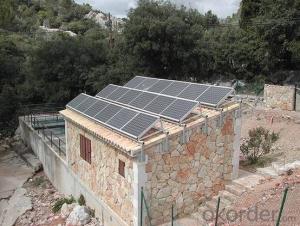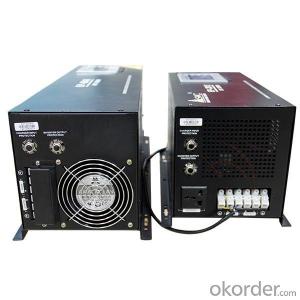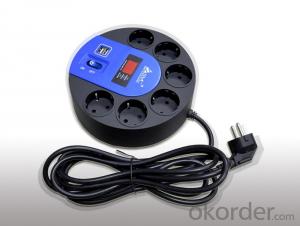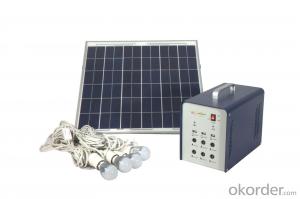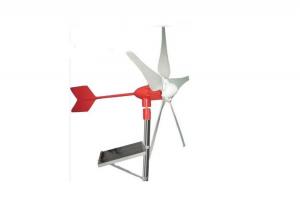Buy Solar Energy Systems - Wind-PV(Diesel) Hybrid Power System
- Loading Port:
- Tianjin
- Payment Terms:
- TT OR LC
- Min Order Qty:
- 2 set
- Supply Capability:
- 30 set/month
OKorder Service Pledge
OKorder Financial Service
You Might Also Like
Specification List
Name | Specification | Quantity | |
1 | Containter | 20*8*8.6ft | 1 |
2 | Solar Module | 240W | 30 |
3 | Wind Generator | 500W | 2 |
4 | Battery | 12V120Ah | 20 |
5 | Controller | 120V/40A | 1 |
6 | Inverter | 6000W/AC230V | 1 |
7 | Diesel | 5000W/AC230V | 1 |
8 | Air Conditioner | 1000W | 1 |
9 | Cables | — | — |
10 | Others | — | — |
2.System Principle
3.System Advantage
Extend battery life |
Reduce the dependence of climate system |
24 hour uninterrupted power supply |
Low maintenance cost |
4.Product Specification
(A) Solar Module
Rated Power | 240W |
Vmppt | 29.4V |
Imppt | 8.17A |
Voc | 37.4V |
Isc | 8.55A |
Power Temp.Coeff(/℃) | -0.47% |
Ambient Temp | -40-85℃ |
Power Tolerance | ±3% |
NOCT | 46℃±2 |
(B) Battery
Rated Voltage | 240V | |
Rated Capacity (C10) | 120Ah | |
Weight | 35kg | |
Dimension | Lenth | 406mm |
Width | 174mm | |
Height | 209mm | |
Capacity | C120 | 150Ah |
C30 | 138Ah | |
C10 | 120Ah | |
C1 | 78Ah | |
Overcharging Protect Voltage | 14.4V/12V | |
Cut off Voltage | 10.8V/12V | |
(C) Wind Generator
Rated Power | 500W |
Rated Wind Speed | 13m/s |
Cut-in Speed | 4m/s |
Cut-out Speed | 25m/s |
Survival Wind Speed | 45m/s |
Mill Diameter | 1.36m |
Mill Height | 1.05m |
Mill Weight | 90kg |
Rated Voltage | AC 42V |
Rated Current | AC 6.9A |
Protection Level | IP54 |
(D) Controller
Solar Controller
Rated Power | 7.2KW |
MPPT | DC120V-350V |
Rated Voltage | DC 120V |
Rated Current | 60A |
Conversion Efficiency | ≥93% |
Overload Capacity | 120% output, 30mins |
Wind Generator Controller
Rated Power | 500W |
Maximum Power | 750W |
Rated Voltage | AC 42V |
E) Inverter
Rated Power | 6000W |
Rated Input Voltage | DC 120V |
Rated Input Current | DC 50A |
Rated Output Voltage | AC 230V |
Rated Frequency | 50Hz |
Rated Current | AC 26.1A |
Output Voltage Precision(V) | 230±5% |
Output Frequency Precision(Hz) | 50±0.05 |
Overload Capacity | 120%, 60S; 150%, 10S |
Inverter Efficiency | 80% |
- Q: Can solar energy systems be used for water heating in swimming pools or hot tubs?
- Yes, solar energy systems can be used for water heating in swimming pools or hot tubs. Solar thermal systems can be installed to harness the sun's energy and heat water for pools or hot tubs, providing a sustainable and cost-effective alternative to traditional heating methods.
- Q: Are there any noise concerns with solar energy systems?
- Yes, there are minimal noise concerns with solar energy systems. Unlike traditional energy sources such as generators or wind turbines, solar panels do not produce any noise while generating electricity. The silent operation of solar panels makes them a preferred choice for residential and commercial installations.
- Q: Can solar energy systems be used for powering shopping malls?
- Yes, solar energy systems can certainly be used for powering shopping malls. With their large rooftops and ample space for solar panels, shopping malls can harness the power of the sun to generate electricity. Solar energy can help reduce reliance on traditional energy sources, lower operating costs, and contribute to a more sustainable and environmentally friendly power supply for shopping malls.
- Q: Can solar energy systems be used in powering telecommunications towers?
- Yes, solar energy systems can be used to power telecommunications towers. Solar energy is a renewable source of power that harnesses the sun's energy to generate electricity. Telecommunications towers require a constant and reliable source of electricity to operate their equipment, and solar energy can provide a sustainable solution for this need. Solar panels can be installed on the tower or in the vicinity to capture sunlight and convert it into electricity. This energy can then be stored in batteries for use during periods of low sunlight or at night. In remote or off-grid locations where access to the electrical grid is difficult or expensive, solar energy systems can be particularly beneficial for powering telecommunications towers. Additionally, solar power reduces dependence on fossil fuels, decreases carbon emissions, and lowers operating costs in the long run. Overall, solar energy systems offer a viable and eco-friendly option for powering telecommunications towers.
- Q: Can solar energy systems be used in areas with limited access to solar energy conferences and expos?
- Yes, solar energy systems can definitely be used in areas with limited access to solar energy conferences and expos. The availability of conferences and expos may provide valuable information and networking opportunities, but they are not essential for the successful implementation and usage of solar energy systems. With the right resources and expertise, communities and individuals can still benefit from solar energy systems, even without direct exposure to conferences and expos.
- Q: Can a solar energy system power an entire home?
- Yes, a solar energy system can power an entire home. With the right size and capacity, a solar energy system can generate enough electricity to meet the energy needs of a household, including powering appliances, heating and cooling systems, lighting, and other electrical devices. However, factors such as the home's energy consumption, the size and efficiency of the solar system, and the availability of sunlight can affect its ability to fully power the home at all times.
- Q: How do solar energy systems impact the energy poverty gap?
- Solar energy systems have the potential to significantly reduce the energy poverty gap by providing affordable and sustainable electricity to those who lack access to traditional energy sources. These systems empower communities to generate their own clean energy, enabling them to break free from reliance on expensive and polluting fuels. Moreover, solar energy can be harnessed in remote and off-grid areas, reaching populations that are often neglected by traditional energy infrastructure. By bridging the energy poverty gap, solar energy systems contribute to socio-economic development, improve living conditions, and enhance opportunities for education, healthcare, and economic growth in underserved communities.
- Q: Can solar energy systems be used for powering agricultural drying or processing operations?
- Yes, solar energy systems can definitely be used for powering agricultural drying or processing operations. Solar energy is a clean and renewable source of power that can be harnessed and utilized to meet the energy needs of various agricultural activities. Solar drying systems can be employed for drying crops, grains, fruits, vegetables, and other agricultural produce. These systems use solar radiation to generate heat, which is then used to dry the agricultural products. Solar dryers are cost-effective, energy-efficient, and have lower operational costs compared to traditional drying methods. They can be particularly useful in regions with abundant sunlight and limited access to electricity. Solar energy can also be used to power various processing operations in agriculture. Solar-powered mills, crushers, pumps, and other machinery can be used for tasks such as milling grains, crushing fruits, or pumping water for irrigation. By utilizing solar energy, farmers can reduce their dependence on fossil fuels and electricity from the grid, leading to cost savings and a more sustainable farming practice. Furthermore, solar energy systems can be combined with energy storage solutions, such as batteries, to ensure a continuous power supply even during periods of low sunlight or at night. This allows farmers to have reliable access to energy for their drying or processing operations throughout the day. Overall, solar energy systems offer a viable and environmentally friendly solution for powering agricultural drying or processing operations. They can contribute to reducing greenhouse gas emissions, decreasing reliance on fossil fuels, and promoting sustainable farming practices.
- Q: Can a solar energy system be used in areas with limited sunlight?
- Indeed, the utilization of a solar energy system remains feasible in regions with limited sunlight. Although solar panels are most effective when directly exposed to sunlight, they are still capable of generating power in areas with limited sunlight. Even on cloudy days or during periods of low sunlight, solar panels can still produce electricity, albeit with reduced efficiency. Furthermore, the advancement of solar panel technology enables panels to capture and convert even diffuse sunlight, enabling their functionality in areas with limited direct sunlight. Additionally, solar energy systems can be tailored to incorporate energy storage solutions such as batteries. This enables the storage of excess energy generated during peak sunlight hours for later use during periods of limited sunlight. Consequently, solar energy remains a viable and sustainable solution for various regions worldwide, even those with limited sunlight.
- Q: Can solar energy systems be used in areas with limited land availability?
- Yes, solar energy systems can be used in areas with limited land availability through various innovative approaches. For instance, rooftop solar panels can be installed on buildings to utilize the available space efficiently. Additionally, solar energy can be harnessed through the installation of solar panels on vertical surfaces, such as walls or fences, or through the use of floating solar farms on lakes or reservoirs. These creative solutions allow for the utilization of solar energy even in areas where land availability is limited.
Send your message to us
Buy Solar Energy Systems - Wind-PV(Diesel) Hybrid Power System
- Loading Port:
- Tianjin
- Payment Terms:
- TT OR LC
- Min Order Qty:
- 2 set
- Supply Capability:
- 30 set/month
OKorder Service Pledge
OKorder Financial Service
Similar products
Hot products
Hot Searches
Related keywords

